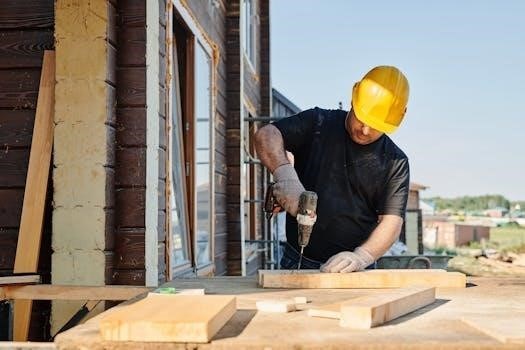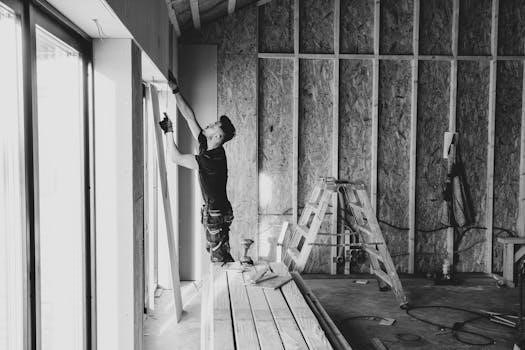Carpentry is a skilled trade involving shaping and installing wood in buildings and structures. It’s a timeless craft that combines practical skills with artistic design, and it forms the backbone of construction. Mastery of these techniques allows for the creation of functional and beautiful structures.
The Relevance of Carpentry in Modern Construction
Carpentry remains indispensable in modern construction, blending traditional methods with advanced techniques. Carpenters are involved in all stages, from the initial framing to the final finishing touches. Their work ensures the structural integrity and aesthetic appeal of buildings. They shape, cut, and install materials for various projects, demonstrating its continued importance in the field; The trade is essential for both residential and commercial projects, showcasing its enduring relevance.
Carpentry Skills and Techniques
Carpentry requires mastering fundamental techniques like sawing, planing, and sanding. Advanced skills involve joinery, shaping, and molding. These skills are essential for constructing durable and aesthetically pleasing structures, blending precision with creativity.
Fundamental Carpentry Techniques
Basic carpentry techniques are the foundation for all woodworking projects. These techniques include sawing, which is the method for cutting wood. Planing is needed for smoothing and flattening wood surfaces. Sanding is essential for finishing wood surfaces, while clamping holds pieces together during bonding. Mastering these skills is the first step to becoming a proficient carpenter, ensuring accurate and secure builds.
Advanced Carpentry Techniques
Advanced carpentry techniques involve more complex skills beyond basic cutting and joining. These techniques include joinery, the art of connecting wood pieces without nails or screws, using methods like mortise and tenon, dovetail, and lap joints. Shaping, molding, scrollwork, and woodturning are also essential, requiring precision and artistry. These advanced skills enable carpenters to craft intricate designs and build complex structures.

Types of Carpentry
Carpentry includes diverse specializations, each with unique techniques and focus. These types include rough carpentry, which involves structural framing, and finish carpentry, focused on finer details like trim and molding.
Rough Carpentry
Rough carpentry is a foundational aspect of construction, focusing on the structural framework of buildings. It encompasses roofing, framing, and formwork for concrete. These large-scale projects don’t usually require fine finishing. This type of carpentry ensures the integrity of a structure. It involves working with heavier lumber and requires a strong understanding of building principles and safety measures.
Finish Carpentry
Finish carpentry focuses on the aesthetic and detailed aspects of building construction, handling trim, molding, and door installations. It involves precision and fine craftsmanship to create visually appealing elements within a structure. Unlike rough carpentry, it emphasizes the final touches and visible components, requiring careful attention to detail and a high level of skill for a polished outcome.

Carpentry Tools and Materials
Carpentry relies on a variety of tools, from basic hand tools to advanced power tools. Understanding lumber types and grading is also essential for selecting appropriate materials for construction projects.
Essential Carpentry Tools
Essential carpentry tools include saws for cutting wood, planes for smoothing surfaces, and clamps for holding pieces together. Measuring tools like tape measures and levels are crucial for accuracy. Drills, routers, and various bits are also necessary for shaping and creating intricate designs. Safety gear, such as glasses and gloves, is equally important.
Lumber Types and Grading
Lumber types vary widely, including softwoods like pine and fir, and hardwoods like oak and maple, each with unique properties. Lumber grading assesses quality, considering factors like knots and grain. Understanding these differences is crucial for selecting appropriate materials for specific construction projects. Knowing the nominal versus actual lumber dimensions is also important for accurate planning and execution.
Carpentry in Building Construction
Carpentry is integral to building construction, from initial framing to finish work. It includes structural framing, concrete formwork, and installation of doors and windows. Carpenters play a vital role in creating safe and functional buildings.
Framing Techniques
Framing techniques are essential in carpentry, forming the structural skeleton of buildings. These techniques encompass methods like balloon framing and platform framing, each with unique construction approaches. Carpenters use their knowledge of lumber and joinery to create stable and durable frameworks. Proper framing ensures the integrity of the building, providing a foundation for subsequent construction phases like roofing and cladding. Mastery of these techniques is crucial for any carpenter.
Formwork for Concrete
Carpentry plays a vital role in creating formwork for concrete structures. This involves constructing temporary molds using wood, into which concrete is poured. The formwork must be precisely built to ensure the correct shape and dimensions of the concrete element. Carpenters utilize their skills in layout and joinery to create sturdy and accurate forms, which are crucial for the successful completion of concrete projects. Proper formwork is essential for structural integrity and aesthetic appeal.
Safety and Regulations in Carpentry
Carpentry requires strict adherence to safety practices and building codes. Understanding regulations and using proper procedures is crucial to prevent injuries. Compliance ensures a safe working environment and structurally sound buildings.
Safety Practices and Procedures
Essential safety practices in carpentry include wearing protective gear like glasses and gloves. Proper use of tools and equipment, along with maintaining a clean workspace, is crucial. Following established safety protocols and procedures prevents accidents and injuries. Understanding the properties of materials and handling them correctly minimizes hazards on construction sites. Regular equipment checks are also vital for ensuring a safe work environment for carpenters.
Building Codes and Standards
Adherence to building codes and standards is crucial in carpentry and construction. These regulations ensure structural integrity, safety, and quality in buildings. Carpenters must be familiar with local and national codes to meet legal requirements. Compliance with standards prevents safety hazards and ensures durable constructions. Understanding material properties and appropriate techniques is essential for code-compliant work. Following established codes guarantees the safety and longevity of structures.
Carpentry Education and Training
Carpentry education involves apprenticeships and technical training programs. These combine practical, hands-on experience with theoretical knowledge. Such training ensures skilled professionals enter the construction field, equipped with the latest techniques and safety practices.
Apprenticeship Programs
Apprenticeship programs offer a structured path to becoming a skilled carpenter. These programs combine on-the-job training with classroom instruction. Apprentices work under experienced carpenters, learning practical skills and construction techniques. They also gain knowledge of safety regulations and building codes. These programs often lead to certifications and careers in the construction industry, ensuring a high level of competency in carpentry.
Technical and Vocational Training
Technical and vocational training programs provide focused education in carpentry skills and building construction; These programs emphasize hands-on learning, utilizing modern tools and equipment. Students learn about construction materials, techniques, and safety procedures. They also develop skills in blueprint reading, construction math, and layout techniques. These programs often include training in green building principles, preparing graduates for careers in the construction field.
The Evolution of Carpentry
Carpentry has evolved through centuries, blending traditional methods with modern innovations. New materials and construction techniques, such as balloon framing, revolutionized residential building. This evolution continues to shape the craft today.
Historical Context of Carpentry
Carpentry is an ancient trade, dating back thousands of years, and it remains vital in modern construction. Historically, carpenters were involved from the start of projects, constructing timber components for roofs, walls, and floors. Traditional methods have shaped the craft, and joinery, the art of connecting wood without nails, is a key element in its history. The use of wood as a building material has been prevalent for centuries.
Modern Innovations in Carpentry
While traditional carpentry focused on hand tools, modern innovations include power tools and advanced machinery, increasing efficiency and precision. Contemporary carpentry integrates these new technologies while still emphasizing a deep understanding of fundamental techniques. Modern developments like mass timber are also changing the way buildings are constructed, and the use of prefabricated materials has reduced construction time. Also, green building techniques are being implemented.

Green Building and Sustainable Practices
Sustainable practices in carpentry involve using eco-friendly materials and techniques. This includes energy-efficient construction methods and employing renewable resources, reducing environmental impact. Carpenters increasingly focus on creating environmentally responsible structures.
Eco-Friendly Building Materials
The use of sustainable materials is essential in modern carpentry. This includes utilizing reclaimed wood, bamboo, and other rapidly renewable resources. These choices reduce the demand on forests and minimize the carbon footprint of construction. Employing materials with low embodied energy is also crucial for environmentally conscious building, promoting a healthier planet and more sustainable construction practices in the industry.
Energy-Efficient Construction Techniques
Implementing energy-efficient practices is crucial in modern carpentry. This includes techniques such as advanced framing, which minimizes thermal bridging, and proper insulation installation. Employing passive solar design and utilizing high-performance windows and doors helps reduce energy consumption. These methods contribute to creating sustainable buildings that are both environmentally responsible and cost-effective. These innovative approaches also enhance the overall comfort of the buildings.
Career Opportunities in Carpentry
Carpentry offers diverse career paths, from general carpentry to specialized fields like cabinetmaking and ship carpentry. These roles involve construction, maintenance, and the use of both traditional and modern techniques.
General Carpenter
A general carpenter is involved in a wide array of construction projects, from building frameworks to installing doors and windows. They utilize various carpentry techniques, working with diverse materials. This role often includes tasks like layout, cutting, and assembling wooden structures, requiring a broad skill set and knowledge of building codes and safety regulations. It is a hands-on profession demanding precision.
Specialized Carpentry Fields
Beyond general carpentry, various specialized fields exist, such as cabinetmaking, focusing on creating detailed cabinetry and furniture. Ship carpentry is another area, dealing with the unique demands of vessel construction and repair. Additionally, there are finish carpenters who specialize in intricate trim work. These fields require advanced skills, attention to detail, and often specialized tools and materials. Each area offers unique challenges and opportunities for growth.

The Enduring Craft of Carpentry
Carpentry’s importance in construction remains unwavering, blending traditional methods with modern innovations. It is a craft requiring skill, precision and creativity. Its enduring nature ensures its continued relevance for years to come.
The Importance of Carpentry in Construction
Carpentry is an indispensable trade within the construction industry, creating structural frameworks and adding finishing touches to buildings. Skilled carpenters blend precision, creativity, and craftsmanship, ensuring structural integrity and aesthetic appeal. From framing to formwork and finishing, carpentry is fundamental in all stages of construction. Its techniques are timeless, demanding knowledge of materials, tools and safety practices.
